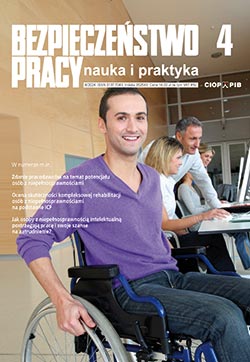International Classification of Functioning, Disability and Health – biopsychosocial model
Agnieszka Ćwirlej-Sozańska, Anna Wilmowska-Pietruszyńska
In 2001, World Health Organization (WHO) adopted International Classification of Functioning, Disability and Health - ICF). ICF is unique classification based on a holistic assessment of a patient. WHO recommended this classification to be used by all Member States. It is intended to introduce a uniform, international language that allows to describe health and related conditions. This classification has already been implemented in many countries, however, it is still not used in Poland.
The aim of this paper is to present the assumptions of the biopsychosocial model of functioning and disability in terms of the International Classification of Functioning, Disability and Health and the view of its implementation.
Ways of coping with stress at work paramedics
Grzegorz Nowicki, Barbara Ślusarska, Dorota Jędrzejewicz
The paramedic profession is accompanied by a wide range of stressful situations, especially: health-threatening as well as life-threatening events, dealing with death and suffering, decisions to terminate CPR, however also interpersonal conflicts and work overload. The paper presents the results of evaluation of stress in the work of a group of professional paramedics and reveals the strategy of the activity undertaken by the respondents in the face of occupational stress.
The findings suggest that approximately 92% of respondents consider their job as stressful. Women have a higher level of stress compared with men. Paramedics in the process of coping with stress most frequently use active coping strategies. Another strategy used is the acceptance, i.e. adoption of the situation and learning how to live with it.
Risk management in the intelligent work environment (2)
Grzegorz Gralewicz
The article proposes a new concept of risk management in the so-called intelligent work environment in field of the occupational health and safety using the new technologies and solutions developed for the needs of safety-related area of work. Specified the functions of security taking into account their potential role in the hierarchy of preventive measures in the area of occupational health and safety.
Risk assessment of noise at the chosen workplaces by the shale gas drilling rig
Witold Mikulski, Izabela Warmiak
One of the major processes at shale gas drilling rigs, from the employee’s point of view, is performing vertical and horizontal search-and-distinct drillings. The article talks about the noise exposure of three employees directly involved in such an endeavor. Noise assessment related to hearing protection was performed at three workplaces. The measurements show the employees hired at the mentioned rig – driller helpers at the hole and at the tower, are subjected to noise exceeding the highest permitted levels in relation to hearing protection (OEC of noise)
Harmonisation of exposure limits of the strength of electric and magnetic field with the requirements of directive 2013/35/EU
Jolanta Karpowicz, Krzysztof Gryz
European directive 2013/35/UE on the minimum requirements of workers protection against direct and indirect electromagnetic hazards and current Polish labour law, both are based on the framework directive 89/391/EEC. Therefore requirements regarding employers obligations aimed to protect health and safety of workers exposed to electromagnetic fields include many common aspects. The most essential differences include - in Poland it is missing the clear requirement fit the protection rules of medical implant users’ to their individual sensitivity to electromagnetic fields interaction.
Moreover, the harmonisation of exposure limits of the strength of electric and magnetic field (Polish J. of Law No 0, 817, 2014) with the directive 2013/35/EU required that the significant divergence between Polish and European limits of magnetic field in the frequency range 0.1 - 100 MHz will be eliminated. In consequence the transposition of the directive 2013/35/EU can cause the strengthening of evaluation of workers’ exposure to such magnetic fields. Significant changes in the requirements regarding the protection of workers in the vicinity of sources of electromagnetic field of other frequencies, are not expected because of the harmonization of exposure limits with the directive 2013/35/UE, which is going to be release in 2016.




























